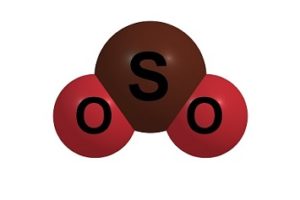The combustion of fossil fuels accounts for 75% to 85% of emissions of sulfur dioxide (SO2), but the chemical is also generated by multiple industrial activities, including the manufacture of hydrosulfites and other sulfur-containing chemicals; to bleach wood pulp and paper; to process, disinfect, and bleach food; for waste and water treatment in metal and ore refining; and in oil refining. SO2 has long been recognized as a major environmental air pollutant, and the risks the chemical poses in the workplace are also well established.
According to the National Institute for Occupational Safety and Health (NIOSH), exposure to 100 parts per million (ppm) SO2 is immediately dangerous to life or health. People with chronic lung disease may suffer those effects at a lower ppm. Considering those risks, OSHA has set a permissible exposure limit (PEL) of 5 ppm SO2 averaged over an 8-hour work shift. NIOSH’s airborne recommended exposure limit (REL) is 2 ppm averaged over a 10-hour work shift and 5 ppm not to be exceeded during any 15-minute work period. The American Conference of Governmental Industrial Hygienists (ACGIH) goes one step further, setting its threshold limit value (TLV) at 0.25 ppm averaged over an 8-hour work shift. Furthermore, these exposure limits are for air levels only. When skin contact also occurs, overexposure may be occurring even if the air levels are less than those listed above.
Compressed Gas Standard
When contained in a compressed gas cylinder, SO2 is also subject to OSHA’s compressed gas standard (29 CFR 1910.101). Under the standard, employers must ensure that compressed gas cylinders are in a safe condition to the extent that this can be determined by visual inspection; must conduct in-plant handling, storage, and utilization of all compressed gases in cylinders, portable tanks, rail tank cars, or motor vehicle cargo tanks in accordance with Compressed Gas Association Pamphlet P-1-1965; and must also ensure that compressed gas cylinders, portable tanks, and cargo tanks have pressure relief devices installed and maintained in accordance with Compressed Gas Association Pamphlets S-1.1-1963 and 1965 addenda and S-1.2-1963.
Also, where possible, it is generally recommended that SO2 be transferred from cylinders to other containers in an enclosed system.
Respirators Needed?
According to the New Jersey Department of Health (NJDOH), where the potential exists for exposure over 0.25 ppm, use of a NIOSH-approved full face-piece respirator with an acid gas cartridge specifically approved for SO2 is recommended. Also regarding respirators, the NJDOH recommends the following:
- Leave the area immediately if (1) while wearing a filter or cartridge respirator, SO2 can be smelled, tasted, or otherwise detected; (2) while wearing particulate filters, abnormal resistance to breathing is experienced; or (3) if eye irritation occurs while wearing a full face-piece respirator.
- Consider all potential sources of exposure in the workplace. Workers may need a combination of filters, prefilters, or cartridges to protect against different forms of SO2 (e.g., vapor or mist).
- Where the potential exists for exposure over 20 ppm, use a NIOSH-approved supplied-air respirator with a full face piece operated in a pressure-demand or other positive-pressure mode.
- If the possibility of exposure above 100 ppm exists, use a NIOSH-approved self-contained breathing apparatus with a full face piece operated in a pressure-demand or other positive-pressure mode equipped with an emergency escape air cylinder.
NIOSH’s complete list of respirator recommendations for SO2 levels in the workplace is at https://www.cdc.gov/niosh/npg/npgd0575.html.

